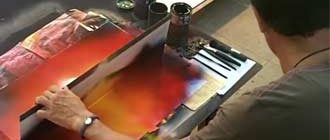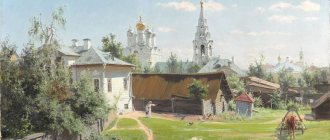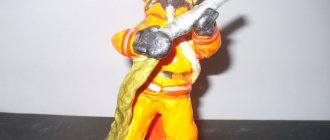Introducing landscape painting to preschool children
Content
Introduction……………………………………………………………………………………3 I. Introducing landscape painting to preschool children…….4 1.1. The importance of painting in comprehensive development preschoolers……5 1.2. Objectives of familiarizing preschoolers with works of art...7 II. Methodology for introducing painting to preschool children……8
Conclusion……………………………………………………………………………….13
References……………………………………………………………14
Introduction
Landscape painting is one of the means of education and development of preschool children. Preschoolers communicate with nature at different times of the year - both when there is fluffy snow around, and when the gardens are blooming, and thus can compare real events with pictures. Thus, the child, with the help of his senses, perceives the variety of properties of natural objects: shape, size, sounds, colors, spatial position, movement, etc. He develops specific initial and vivid ideas about landscapes, which later help him to see and understand the connections and relationships of natural phenomena and to learn new concepts. Many are in the process of observation. This allows the teacher to develop logical thinking in students. Communication between children and nature also has ideological and ideological significance. The accumulation of real, reliable ideas, understanding of the interactions of natural phenomena lies at the basis of the subsequent formation in children of elements of a materialistic worldview. Nature has always served as the content of fine art, including children's. The drawings created by children help to consolidate and clarify their knowledge about natural objects, form an interest in nature and a positive attitude towards it. In this regard, the targeted introduction of children to landscape painting should be carried out as a single process of natural science and aesthetic knowledge. This process must be carried out in such a way as to evoke in children a positive attitude towards landscapes and vivid emotional experiences. All this increases interest in nature and makes you want to reflect its phenomena in your creativity. By depicting nature, children again experience aesthetic feelings for it, which makes their life more interesting and meaningful. Familiarizing older preschoolers with nature affects the level of knowledge about natural phenomena and objects, a positive emotional and aesthetic attitude towards them, and most importantly, the content and quality of children's drawings, the use of a variety of expressive means in them. The beauty of any natural phenomenon evokes an enthusiastic response in the soul of a child. Introducing children to landscape painting contributes to their emotional and aesthetic development, fosters a kind and caring attitude towards nature, and awakens a sincere, ardent feeling of love for their land, their native land. Landscape painting can not only bring joy, but also inspire creativity.
I. Introducing preschool children to landscape painting
Introducing children to landscape painting is preceded by preliminary work - the joint activity of the teacher with the children, which is expressed in observations during walks, admiring nature, and in identifying the poetic image of nature. And then, based on the child’s small but personal experience and relying on previous observations, you can lead the child to become familiar with landscape painting. Such familiarization is carried out in the form of a conversation in a joint activity in the middle and senior groups or as part of an educational lesson or a lesson in visual arts. Landscape (from the French paysage - area, country) is one of the most emotional, most lyrical genres of fine art, the subject of which is the image of pristine or man-altered nature. The object of such an image is also called a landscape. Along with the concept of “landscape”, there is the concept of “landscape” (German land - land and schaft - view) - a general view, a panorama of any area. Familiarity with the landscape, that is, mastering the techniques of depicting it in a drawing, has a great influence on the artistic development of the child’s personality and the development of his aesthetic taste. Children learn to understand and feel color, to catch the slightest changes in color, which affects the development of observation and the ability to notice everything new and interesting in nature and in life. Knowledge of color combinations develops in children a good aesthetic taste not only in painting, but also in clothing and interior design. Thus, all work to familiarize children with the landscape is aimed at developing an emotionally holistic perception of painting in preschool children, at teaching children to see, understand and depict the world around them. When introducing children to landscape painting, I set the following tasks:
- Introduce children to the type of painting - landscape.
- Learn to understand the intent of the work and its content.
- Develop the ability to see the means of expression used by the artist to convey feelings and moods.
- Enrich children's vocabulary with emotional, aesthetic and art terms.
- Teach children to convey the beauty of the surrounding nature in drawings.
1.1.The importance of painting in the diversified development of preschool children.
Nature is an inexhaustible source of spiritual enrichment for children. Children are constantly in contact with nature in one form or another. They are attracted to green meadows and forests, bright flowers, butterflies, beetles, birds, animals, falling snow flakes, streams and puddles. The endlessly diverse world of nature awakens keen interest and curiosity in children. Impressions of the native nature received in childhood are remembered for a lifetime and often influence a person’s attitude towards nature, towards the Motherland. Drawing is of great importance for the aesthetic education and development of a child. Creating an image requires a number of skills and abilities; it is based on images of perception and ideas. In the process of drawing, a child develops observation, aesthetic perception, emotions, artistic taste, creative abilities, and the ability to independently create something beautiful using accessible means. Drawing classes teach you to see beauty in the life around you, in works of art. Their own artistic activity helps children gradually approach an understanding of works of art. Landscape painting is one of the most lyrical and emotional genres of fine art. Introducing children to this genre contributes to their emotional and aesthetic development, fosters a kind and caring attitude towards nature, its beauty, and awakens a sincere, ardent feeling of love for their land, their native land. An artistic landscape helps develop aesthetic taste, imaginative and associative thinking, imagination, and self-contemplation. Landscape painting not only brings joy to children, but also inspires them to be creative. Experts in aesthetic education believe that the aesthetics of nature is the basis for the formation of an appropriate attitude towards it. By influencing the child’s emotions with its qualities (perfection of form, varied changeable colors), nature evokes aesthetic feelings. This contributes to the emergence and manifestation of attitudes towards objects and natural phenomena. Nature awakens a child’s curiosity, affects his senses, activates sensory development, and forms a sense of beauty. A child learns the beauty of the world around him through the perception of the beauty of nature. Considering the importance of landscape in the development of preschool children, it is necessary to: 1) Develop emotional responsiveness to the aesthetic side of the surrounding reality: create situations for contemplating beautiful views and objects of nature; Show children the beauty of all periods of the day, individual phenomena and states of nature: wind, rain, sky in different weather and seasonal phenomena. 2) Teach the child to independently determine the idea in a landscape drawing and maintain it throughout the entire work, develop compositional skills, place objects in accordance with the characteristics of their shape and size. 3) Create conditions for children’s independent artistic activity outside of drawing classes. Introducing children to nature through visual arts enriches children's creativity with new content, deepens moral and aesthetic feelings, and evokes a desire to preserve and protect nature, care for plants and animals. The process of cognition is carried out in the course of children’s everyday perception of objects and natural phenomena during organized systematic observations. When walking, pay attention to the fact that the color of each season is different. For example, the color of autumn nature differs from winter, in which cold colors predominate; spring is characterized by transparent blue and green colors, and summer is characterized by sunny, bright, warm colors and shades. Attach great importance to the artistic word in the aesthetic education of children, since literature develops the aesthetic taste of preschoolers, aesthetic perception, and teaches them to find true beauty in everyday life. Taking into account the ideas formed in children, I draw their attention to the fact that the poet, noticing interesting things in nature, reflects this in a poem, and the artist, illustrating the text, strives to draw what the poet said. I introduce children to a short work that describes a familiar image or a simple picture of nature, and at the same time show a bright illustration to it. Such a complex impact of emotional, visual and auditory images helps to better achieve the goal of studying the landscape. The beauty of any natural phenomenon evokes an enthusiastic response in the soul of a child. Introducing children to landscape painting contributes to their emotional and aesthetic development, fosters a kind and caring attitude towards nature, and awakens a sincere, ardent feeling of love for their land, their native land. Landscape painting can not only bring joy, but also inspire creativity.
1.2 Objectives of familiarizing preschoolers with works of art
In the process of developing an aesthetic attitude towards painting in children, the main thing is the emotional and imaginative perception of works of art, visual and expressive means, the formation of interests and preferences. Children's activities related to painting should always be relaxed, full of joyful aspiration, creative imagination, and initiative. The more aesthetically developed a child is, the stronger his artistic skills and abilities, the more complete his creative activity. Objectives of introducing children to painting:
1. To develop a sustainable interest in painting in children. To bring to the understanding that art reflects the world around us and the artist depicts what aroused his interest and surprise. 2. Introduce what and how art speaks about. Learn to see the features and distinctive features of different types of art. 3. Continue work on developing the skills of consistent, holistic artistic perception of truly artistic works of art. 4. To develop skills and abilities to communicate about art with friends and adults, to express judgments and assessments of what they see. 5. To develop the ability to admire works and understand the mood of the hero. Requirements for working with preschool children: - Accessibility of the content of painting for children's perception. The theme of the paintings must be in tune with the interests of children and correspond to their age and experience. — The content of the picture should be of an educational humanistic nature, contributing to the formation of moral and aesthetic qualities, feelings, and relationships. — Vivid expression of the emotional state. The more emotional, brighter, and more convincing a work is, the stronger its effect on the feelings and consciousness of the audience, and the deeper it reveals the very content of the image. — The variety of means of expression used by the artist: color, composition, rhythm. Art helps to cultivate different feelings. Thus, when familiarizing themselves with landscape painting, children become more interested in social life, in various types of human activity, in their relationship to labor processes, to the values that people create, and to artistic creativity. Children enrich their moral experience and love for the Motherland. They develop a moral consciousness.
II . Methods of introducing painting to preschool children
Starting from the senior group, various forms and methods of work are used in working with children to familiarize themselves with landscape painting. Thanks to these forms and methods, the teacher teaches them to see how the artist depicts the beauty of the surrounding nature at different times of the year (the many colors of golden autumn, the transparency of spring). Children master the ability not only to see and understand the content of the picture, but to feel what the artist wanted to convey when depicting nature (joy, sadness). Art history activity.
The structure of an art history lesson could be something like this: 1. Introductory part.
Here the teacher emotionally prepares the children for further perception of works of art. These can be interesting game situations (“Why did the artist make a mistake?”, “Find the mistake in the painting”, situations where children organize and “attend” art exhibitions, vernissages). 2 Main part. A message about the names of the paintings that the children will be introduced to. Name the artists. In one lesson in the senior and preparatory groups, you can show 2-3 familiar works and one new work, unfamiliar to the children. Using various methods of work, the teacher teaches how to compare works of art, develops the ability to see and understand the idea and content of the work. This should be done in a non-boring, unobtrusive, interesting, entertaining way. After examining and comparing works of art, you can conduct didactic games to consolidate the acquired knowledge. 3. Final part. In this part, the teacher, together with the children, analyzes the new knowledge acquired, the children share their impressions, and the children’s activity in the lesson is analyzed. Most of the work in such a lesson is taken up by art history stories. The choice of an art history story as a method of introducing landscape painting is determined by the content and structure of the work, which reflects its elements in a logical relationship. The structure of an art history story can be something like this: a message about the title of the painting and the name of the artist, what the landscape is written about, what is most important in the painting, how it is depicted (color, construction, location), what is depicted around the main thing in the work and how the details are connected to it (this is how we delve deeper into the content of the picture, while a connection is established between the content of the work and the means of its expression), what beautiful things the artist showed, what you think about, what you remember when you look at this picture. Using this story structure is possible until children begin to adequately answer the questions posed about the content of the picture and acquire the skill of monologue speech when answering the question of what the picture is about. At the first stages of introducing children to landscape painting, the technique of “entering the picture”, recreating events preceding and subsequent to the content of the picture, justifies itself. The use of this technique is also advisable because it is closely connected with play, creative imagination, and with a certain kind of orientation towards detailed expressive storytelling. This is how the child’s thoughts are directed to create a coherent, expressive story of a certain structure. For example, as a child does: “It seems to me that there were tall pine trees here. They were dense, shaggy, and stretched upward. Some have dark trunks, while others have light trunks, like in Shishkin’s painting, which we have already seen. The wind blew between them, the pines creaked as if they were angry. But then a truck arrived, brought people with saws, and they began to cut down the pine trees. Everything changed immediately. The trucks growled and the saws clanged. One pine tree was taken to a kindergarten to celebrate the New Year, and beautiful houses were built from the rest so that people could live happily. (Shishkin I. “Ship Grove”). One of the most common methods of work is an example of the teacher’s personal attitude towards the picture he liked. This method makes it possible for the child to build his own story using the example of an educational high-quality story. In the practice of working with older children, you can use work with differentiated subgroups. Such subgroups include children who have the same level of intellectual and emotional development and approximately the same understanding of the content of landscapes and express their impressions in speech. There are the following levels of understanding of a child’s landscape painting: 1) high level:
answers questions correctly, comprehensively, logically.
Can he independently determine what is depicted, what the picture is about, what the artist wanted to show by painting this picture? 2) intermediate level
: answers questions correctly, but does not know how to prove why he thinks so, that the picture tells exactly this, weakly uses epithets and figurative comparisons in speech.
3) low level:
finds it difficult to answer questions posed, reveals insignificant connections and content of landscapes, does not know how to find expressive means.
There are also indicators of the levels of emotional and personal attitude of preschoolers to works of landscape painting. In their free time from classes or at the request of the children, they use a variety of didactic games to familiarize themselves with landscapes. For example, “Find out by description”, “What would happen if the artist changed. . . ? “Find commonality,” etc. Excursions. Exhibitions. Children receive a special emotional charge during excursions to the “Art Hall”. Some modern preschool educational institutions have conditions for organizing exhibitions of reproductions of landscapes. Here children acquire the skill of cultural communication with works of art, the skills of visiting museums, which in the future they will visit without adults. Thus, children develop the ability to exchange impressions when viewing a picture in a calm, even voice, and when they need to speak loudly, they do not need to raise their hand, as happens in class. At the request of the children, you can prepare “tour guides” from among the students, who could independently talk about 2-3 works of art, their authors and the unique style of landscapes. Individual work.
It is carried out with children who have not acquired knowledge about new works in fine arts classes, as well as with closed, shy children with absent-minded attention, who have not shown any interest in landscape painting, with an underdeveloped emotional sphere. Individual work is also carried out with gifted children, who have a pronounced, stable interest in works of landscape painting and visual arts, characterized by high activity and developed emotional speech. If with the first children the teacher can limit himself to only a detailed examination of one or two works, then with the second it is possible to use a combination of activities; viewing landscapes, reading landscape literary lyrics and independent artistic activity of children.
Entertainment.
One of the forms of introducing preschoolers to landscape painting is entertainment. The structure may be as follows (let's look at one of them as an example). Entertainment “How beautiful our world is” may consist of the following points:
- an emotional story from the teacher about the paintings of one or more artists, about the magical world of colors (such a story is better perceived against the background of music, which enhances the emotional impact on children);
- exhibition of reproductions of paintings;
- competition for the best child’s story about the picture they liked;
- conducting the game “Music and a Picture”, in which preschoolers practice relating a piece of music to the mood expressed in the picture;
- quiz about paintings and their artists;
- children's mental creation of their own picture based on the name given to the artist's painting.
For a deeper understanding of the artistic value of a painting, it is necessary to have unity in the perception of the content (what is depicted) and the means of expression (how the content is expressed), i.e. forms of the work. In the selection of works by form, the principle of diversity in the means of expression and manner of use used by artists is taken into account. Paintings by different artists differ in the manner of execution, the rhythm of lines, strokes, stylization, generalization or detail of images, three-dimensional or planar image. They also take into account the principle of concentricity, the essence of which is to return to previously perceived pictures, but at a higher level of cognition. The same picture is repeatedly offered for children to examine during the school year and in different groups. Children of senior preschool age have access to the themes reflected in landscape painting: effective love and caring attitude of man towards the earth and nature. There is another principle that is taken into account when selecting works of art - an individual creative vision of reality in similar themes of works. Preschoolers are introduced to landscapes by different artists on the same theme. By perceiving these paintings, children acquire the ability to compare different manners of execution of the same phenomenon by different artists, and to highlight their attitude to what is depicted. One of the main tasks of education is the task of developing social emotions and feelings in children. The Concept of Preschool Education speaks about ways to expand children’s own emotional experience: “When communicating with adults, a child discovers for you a range of new feelings, emotional shades... For the first time, he begins to experience the joy of learning..., anxiety for others, pride in his success, and masters the language of emotions.” One of the means to achieve this goal is pedagogical work to familiarize students with works of art, including landscape painting. In landscape painting, there are special requirements for working with preschool children. 1. Accessibility of the content of landscape painting for children's perception. The theme of the paintings must be in tune with the interests of children and correspond to their age and experience. 2. The content of the picture should be of an educational humanistic nature, contributing to the formation of moral and aesthetic qualities, feelings, and relationships. 3. Vivid expression of the emotional state. The more emotional, brighter, and more convincing a work is, the stronger its effect on the feelings and consciousness of the audience, and the deeper it reveals the very content of the image. 4. The variety of means of expression used by the artist (color, composition, rhythm). Here are only the basic requirements for the selection of works of art that can be used in working with preschoolers. It is clear that the teacher, introducing children to landscape painting, takes into account age, psychological and individual characteristics and the level of their intellectual, emotional, aesthetic development, the possibility of equipping the pedagogical process with visual aids and, finally, the peculiarities of the functioning of the preschool educational institution, its location (city, village), where the child grows and develops. Showing creativity, the teacher will improve the methodology for selecting works of art, with the help of which he can open the child’s door to the world of artistic vision.
Conclusion
The formation of a creative personality is one of the important tasks of pedagogical theory and practice at the present stage. Solving it should begin in preschool age. The most effective means for this is the visual activity of children in a preschool institution. In the process of drawing, a child experiences a variety of feelings: he is happy about the beautiful image that he created himself, and he is upset if something doesn’t work out. But most importantly, by creating an image, the child acquires various knowledge; his ideas about the environment are clarified and deepened; In the process of work, he begins to comprehend the qualities of objects, remember their characteristic features and details, master visual skills and abilities, and learn to use them consciously. In the process of developing an aesthetic attitude towards painting in children, the main thing is the emotional and imaginative perception of works of art, visual and expressive means, the formation of interests and preferences. Children's activities related to painting should always be relaxed, full of joyful aspiration, creative imagination, and initiative. The more aesthetically developed a child is, the stronger his artistic skills and abilities, the more complete his creative activity. Art helps to cultivate different feelings. Thus, when familiarizing themselves with landscape painting, children become more interested in social life, in various types of human activity, in their relationship to labor processes, to the values that people create, and to artistic creativity. Children enrich their moral experience and love for the Motherland. They develop a moral consciousness. The beauty of any natural phenomenon evokes an enthusiastic response in the soul of a child. Introducing children to landscape painting contributes to their emotional and aesthetic development, fosters a kind and caring attitude towards nature, and awakens a sincere, ardent feeling of love for their land, their native land. Landscape painting can not only bring joy, but also inspire creativity.
Bibliography
1. Vetlugina N.A. “Aesthetic education in kindergarten”, M., P., 1985. 2. Zubareva “Children and fine arts”, M., 1969. 3. Kompantseva V.V. “Poetic image of nature in children’s drawings”, M., 1985. 4. Sokolnikova N.V. “Fine art and methods of teaching it in elementary school”, M., 1999. 5. Stasevich V.K. "Scenery. Picture and reality", M., P., 1978. 6. Chumicheva R.M. “For preschoolers about painting”, M., 1992.
14
Genres of painting for children 2-3 years old
A child’s acquaintance with art should begin at the age of 2-3 years. At this age, three genres are appropriate: landscape, portrait, still life. You should not explain to your child the meaning of the painting and talk about the artist’s biography. It is necessary to create a cultural space around the child to cultivate good taste.
In the children's room you can organize a small home exhibition (reproductions of paintings by Vasnetsov, Perov, Aivazovsky, Shishkin...), which will be gradually updated and expanded. Parents need to learn to capture children's emotions that the picture evokes. The baby notices beauty, perceives it and receives joy when it comes into contact with it. This is how a child’s first interaction with art occurs.
The French writer Françoise Barbe-Galle gives in her book “How to Talk to Children about Art” an exact comparison of this emotional contact with art: “We can admire a flower without being able to read its Latin name and generally having no idea what it is called.”
For a two-year-old child, a painting is the most interesting object of study. Examine and describe with him what is depicted on it, study the colors, search for objects...
Parents should pay attention to the baby’s reaction and select for viewing those reproductions that will be of interest to him.
In the process of communication, the mother draws the son’s (daughter’s) attention to the reproduction of the painting: “Look out the window. How green the trees are in our yard! They are very tall! And what beautiful trees are depicted in this picture! This is a forest. In the forest you can hear birds singing..." (reproduction of I. I. Shishkin’s painting “Forest”) or

S. Rodionova “Still life with apples”
“Help me put apples in a vase! They are so red, just like in the painting. Look at the picture! Do you like apples? (reproduction of Svetlana Rodionova’s painting “Still Life with Apples”) or “What a handsome boy! His name is Mika. What is he doing? Sits on a chair. His cheeks are pink! Curly hair! The eyes are big! Where is he looking? Maybe he saw a little titmouse outside the window? (reproduction of V. A. Serov’s painting “Mika Morozov”).”
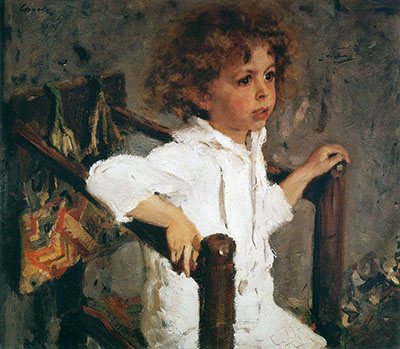
V. A. Serov “Mika Morozov”
When studying the primary colors in painting (red, yellow, blue), you can use reproductions of paintings from different genres where these colors dominate.
This you need to know:
It is very important to observe the measure in the number of reproductions.
For children's perception, it is best to choose large format reproductions (A4, A3) with large contrasting images.
All work should be located at the child’s eye level.
Portrait (French portrait - image)
This genre involves depicting the external or internal appearance of one person or several people. That is, this is not only a repetition of the forms and lines of a specific figure, but also ideological and artistic work on the inner world of a person. The term portrait itself was originally applied to any object that could be depicted, until in the seventeenth century it began to be applied only to a person.
In Ancient Egypt, portraits (at first sculptural) were created only so that the soul of the deceased, returning after the trial, could find the buried body and settle in its mummy (sculpture). From the 10th to 12th centuries, portraits were used for tombstones, minted on coins, and depicted in books. Most often, this was awarded to noble persons. The heyday of the genre began with the Renaissance, when man was assigned a special role in the world. In Russia, the portrait genre developed in the Middle Ages, and the first portraits date back to the 11th-13th centuries.
Portraits are divided into ceremonial and chamber. Firstly, the artist must exalt an important person, which is why she is usually depicted in festive clothes in luxurious interiors or landscapes in full height. Secondly, the background is less pompous, and the person himself is depicted only from the shoulders, chest or waist. Ceremonial portraits were created, for example, by B. Kustodiev, V. Borovikovsky, O. Kiprensky, and A. Kharlamov, P. Chelishchev, A. Samokhvalov, A. Yakovlev and others worked with chamber versions.
It is worth highlighting separately the miniature portraits that were inserted into medallions or carried in cases or snuff boxes. One of the virtuosos in this genre was V. Borovikovsky. And also the genre of self-portrait, when the artist depicted himself. Such a picture allows us to understand in many ways the artist’s worldview, his vision of himself. Most masters painted a self-portrait at least once, and some created dozens of them (for example, V. Popkov).
With the development of avant-garde art, the portrait genre also underwent radical transformations. Instead of classical versions, fragmented cubo-futuristic portraits of Yu. Annenkov, A. Bogomazov, N. Goncharova, A. Lentulov, modernist portraits of B. Grigoriev, bright impressionist paintings of K. Korovin and A. Arkhipov, Orphic versions of S. Delaunay, sculptural painting appeared on the stage V. Ermilova and many others.
Animalism (lat. animal - animal)
The animalistic genre arose in ancient times, when the first people painted predatory animals on the rocks. Gradually, this direction grew into an independent genre, implying an expressive depiction of any animals. Animalists usually have a great interest in the animal world, for example, they can be excellent equestrians, keep pets, or simply study their habits for a long time. As a result of the artist's intentions, animals can appear realistic or in the form of artistic images.
Among Russian artists, many were well versed in horses, for example, V. Vasnetsov and V. Serov. Thus, in Vasnetsov’s famous painting “Bogatyrs”, heroic horses are depicted with the greatest skill: the colors, behavior of the animals, bridles and their connection with the riders are carefully thought out. Serov did not like people and considered a horse in many ways better than a person, which is why he often depicted it in a variety of scenes. Although I. Shishkin painted animals, he did not consider himself an animal painter, so the bears in his famous painting “Morning in a Pine Forest” were created by the animal painter K. Savitsky.
In tsarist times, portraits with pets, which were dear to man, became especially popular. For example, in a painting by V. Borovikovsky, Empress Catherine II appeared with her beloved dog. Animals were also present in the portraits of K. Makovsky, Z. Serebryakova, K. Bryullov and other Russian artists.
Among the primitivists N. Pirosmani and L. Gudiashvili, animals came out especially touchingly with lively eyes, as if they were coming to life in the paintings.
Examples of paintings by famous Russian artists in the genre of animalism
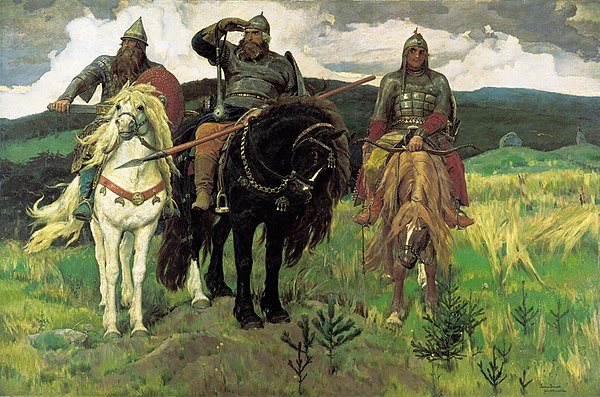
Painting by V. Vasnetsov “Bogatyrs”. 1881–1898
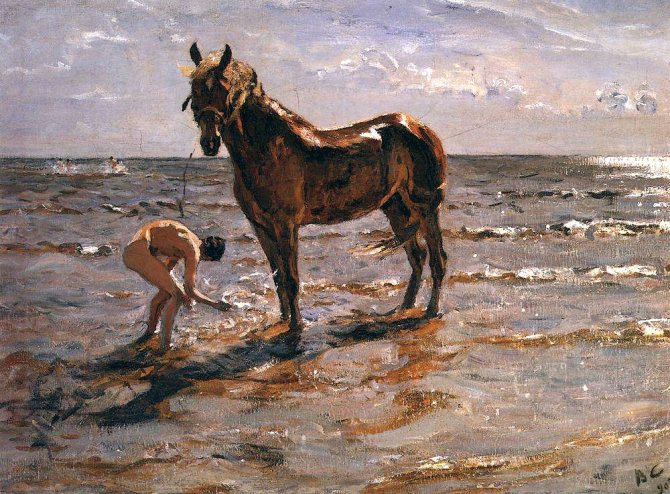
Painting by V. Serov “Bathing a Horse”. 1905
Painting by V. Borovikovsky “Catherine II on a walk in Tsarskoye Selo Park.” 1794
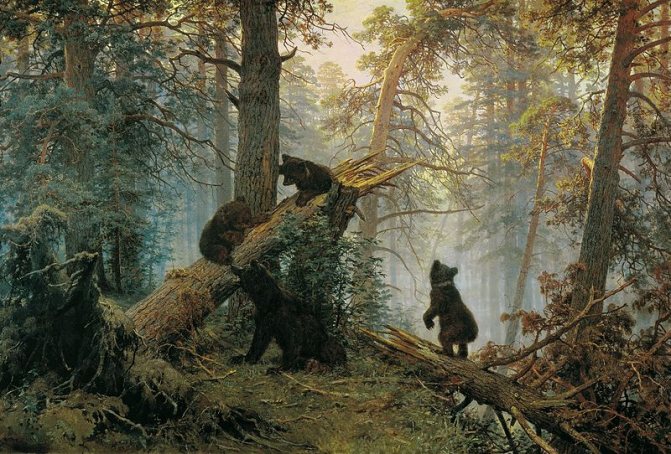
Painting by I. Shishkin and K. Savitsky “Morning in a pine forest.” 1889
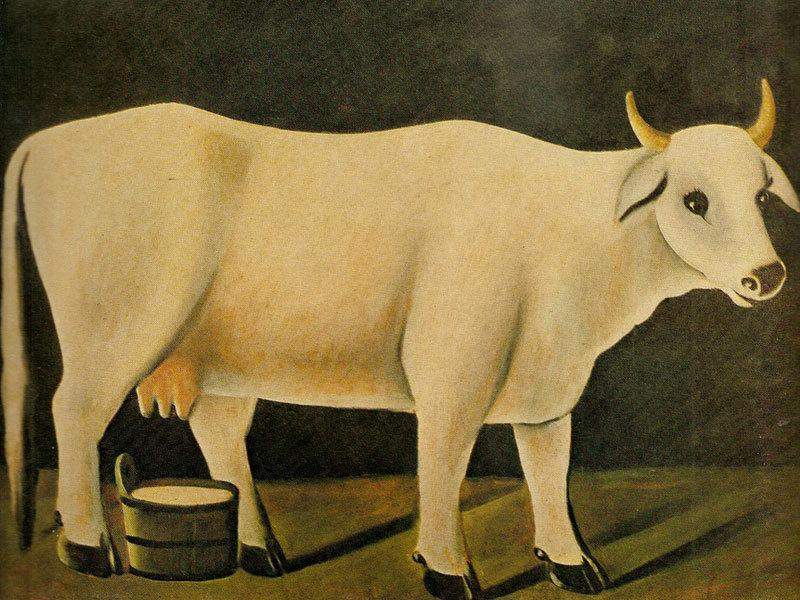
Painting by N. Pirosmani “White cow on a black background.”
History of the emergence and development of painting
The history of painting dates back to the time when a person first depicted something on a surface using paint. This happened, according to scientific data, 40-12 thousand years ago, during the Late Paleolithic era. This is evidenced by preserved rock paintings in caves in the territories of Southern France, Northern Spain and other countries.
The drawings were made using earthen paints, the color of which varied depending on the impurities in the soil. For example, the natural yellow pigment ocher was “found” where the iron content was high. The oxidized metal gave the earth a characteristic rusty tint. Brown, brown, greenish dye, known as umber, was found in soils rich in manganese oxides. They did not disdain charcoal and soot.
The pigment was applied to the walls of the caves using pieces of fur, split sticks, and fingers. Images of animals, and later of hunting scenes, turned out to be expressive and truthful, despite the lack of a compositional element. The first depicted human figures appeared in the 8th-4th centuries. BC. The range of colors became wider thanks to the appearance of pigments obtained by grinding variegated minerals (lapis lazuli, cinnabar) into powder. At the same time, in the Neolithic era, casein, albumin, gum resins and other binders appeared. Mixing them with multi-colored stone flour produced paints of varying consistency.
In the ancient period, “rock” painting was already at a higher level. Associated, as a rule, with the funeral cult, it was of a narrative nature. A compositional plot emerged: the relationship and arrangement of human figures indicated the existing hierarchy from master to slave; everyday, battle scenes told about the vicissitudes of life of people of that era.
What is a genre of fine art?
The French word "genre" is translated as "genus", "species".
An artist may give preference to one genre or one type of fine art, or he can work successfully in different genres and in different types of fine art (painting and sculpture, painting and graphics...)
Usually the artist is called by the genre that is the main one in his work (battle painter, animal painter, portrait painter, landscape painter...)
All works of fine art are divided into genres that can merge (the Monument to Minin and Pozharsky can be classified as a portrait and a historical genre) and branch out (I.K. Aivazovsky wrote marinas (seascapes) and battles (sea battles). The battle genre can be classified as "branches" of the historical genre).


